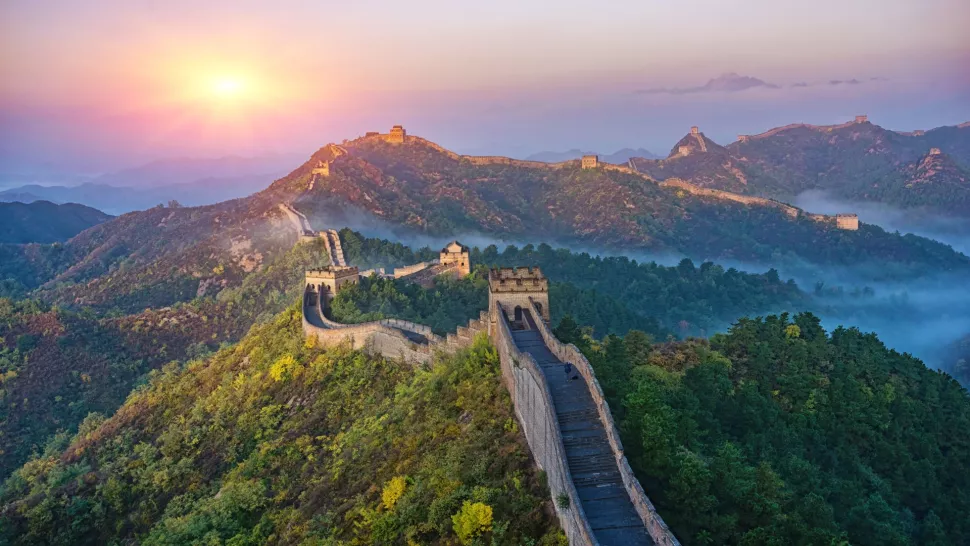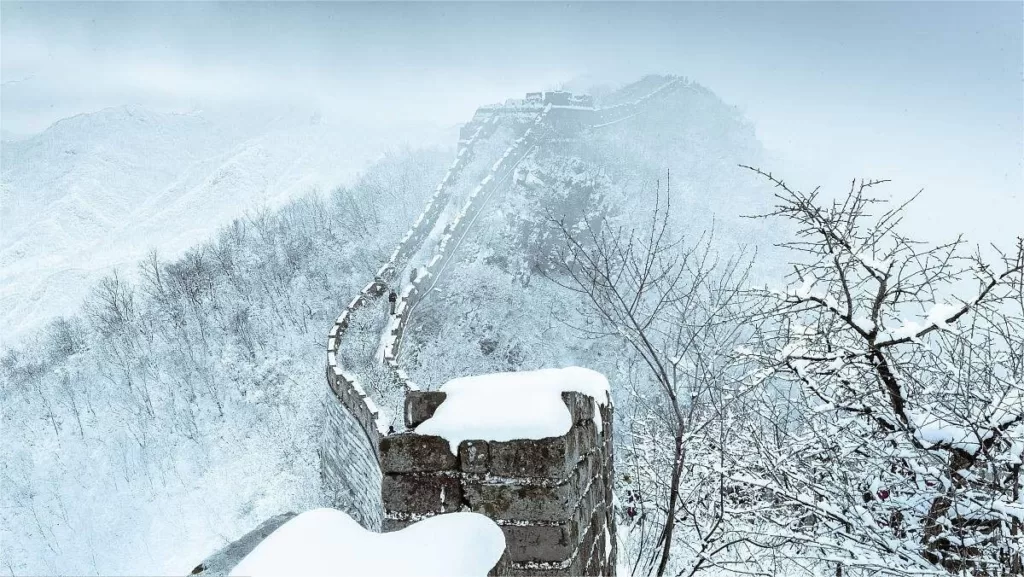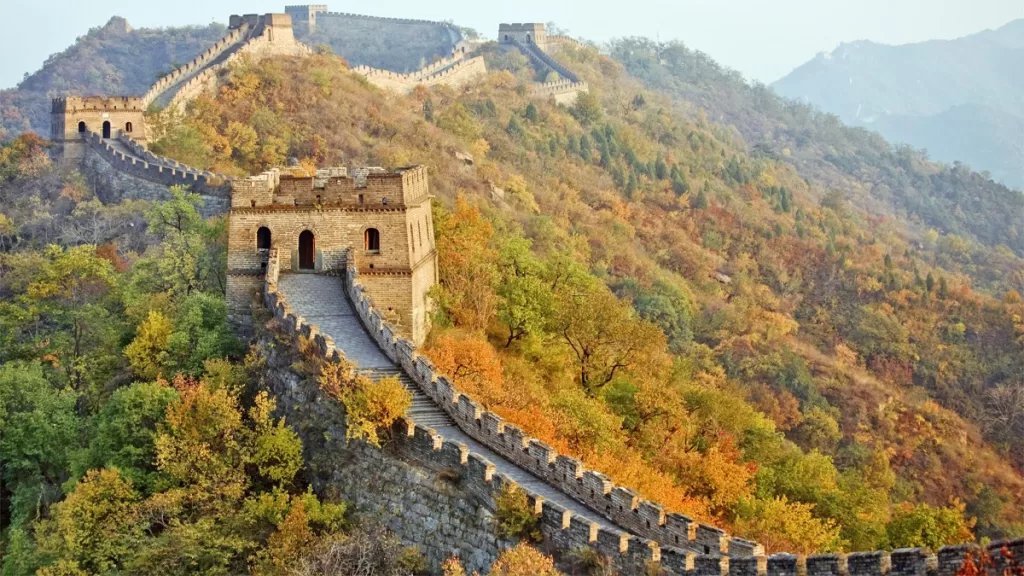Huanghuacheng Water Great Wall (黄花城水长城, Yellow Flower City Water Great Wall) is a unique and captivating section of the Great Wall located in Huairou, Beijing, specifically in Huanghuacheng. The name originates from the submersion of a segment of the Great Wall due to the construction of a reservoir, resulting in a distinctive landscape known as the “Great Wall in the Water.” This location boasts a special charm with its mingling of ancient fortifications and water, creating a picturesque scenery.
During the midsummer season, Huanghuacheng is adorned with vast expanses of yellow wildflowers, making it an ideal spot for capturing the beauty of summer blooms. The Water Great Wall at Huanghuacheng is renowned for three remarkable features that visitors should not miss.
The first highlight is the majestic and formidable Great Wall, constructed during the Ming Yongle era (1404). It winds its way along the mountain ridges, encircling the shores of the expansive Honggu Lake, offering breathtaking and magnificent views. This section of the Great Wall not only served as the northern gateway to protect the capital but also played a crucial role in safeguarding the Ming Dynasty’s imperial tombs, known as the “Thirteen Tombs.” It represents the essence of the Ming Dynasty’s Great Wall.
The second highlight is the natural division created by the lake, where the waters naturally separate three segments of the Great Wall, resulting in the unique spectacle of the Great Wall interacting with the water – a phenomenon unparalleled in China.
The third highlight is the ancient chestnut orchard from the Ming Dynasty, characterized by twisted and gnarled trees with diverse shapes. The soldiers who guarded the city during the Ming Dynasty diligently planted large areas of Ming chestnut orchards. Despite enduring the passage of time, these ancient chestnut trees remain vibrant and lush, forming a one-of-a-kind cultural spectacle in the outskirts of Beijing.
Table of Contents
- Basic Information
- Location and Transportation
- Highlights of Huanghuacheng Water Great Wall
- Map and Recommended Routes
- Vlog about Huanghuacheng Water Great Wall
- Best Time to Visit
- Popular Restaurants near the Great Wall
- Photography Spots and Tips
- Other Sections of Great Walls in Beijing
Basic Information
| Estimated Length of Tour | Over 3 hours |
| Ticket Price | Admission: 60 RMB Boat Cruise: 45 RMB |
| Opening Hours | 8.30 – 17.00 (1st May – 23rd October) 8.30 – 16.30 (24th October – 30th April the next year) |
| Telephone Number | 0086-010-61651111 0086-010-61651818 |
Location and Transportation
Huanghuacheng Water Great Wall is situated in the Huairou District, approximately 70 kilometers north of Beijing, China. Nestled amidst the beautiful landscape, it is conveniently located within reach of the bustling capital city. To get there, you can choose one of the following ways:
Public Transport:
- Route 1: Take Bus 916 Express from Dongzhimen Transport Hub to “Nanhuayuan Sanqu (南华园三区)” in Huairou. Walk 100 meters to “Nanhuayuan Siqu (南华园四区)” or “Tax Bureau Station (地税站).” Transfer to the “Huairou-Water Great Wall” bus.
- Route 2: Take the “Changping-Jiuduhe Special Line (昌平—九渡河专线)” from Changping Long-distance Bus Station or Changping Changling Intersection to Jiuduhe Gas Station. Transfer to the “Huairou-Water Great Wall” bus.
Tourist Shuttle Bus:
- Route 1: Direct bus from Dongzhimen Transport Hub (东直门公交枢纽) on weekends and public holidays between 8:00-9:00 AM.
- Route 2: Direct bus from Xuanwumen Northeast Corner (near the Catholic Church, Metro Xuanwumen Station Exit B) on weekends and public holidays between 7:30-8:30 AM.
Highlights of Huanghuacheng Water Great Wall
Ming Great Wall

Huanghuacheng Great Wall is named after the yellow flowers that blanket the area. This section of the Great Wall is 12.4 kilometers long, making up 20% of the Great Wall’s total length within Huairou, which is 61.5 kilometers. It features 40 hollow watchtowers, 9 solid watchtowers, 5 wall platforms, and 8 passes. Construction began in the second year of the Yongle reign (1404) and was completed in the twentieth year of the Wanli reign (1592), taking 188 years, nearly two centuries, to finish. Huanghuacheng served as the northern gateway to protect Beijing and as a crucial entrance guarding the Ming Tombs. Unlike the grandeur of Badaling or the picturesque elegance of Mutianyu, Huanghuacheng retains a primitive and rustic charm, offering a sense of historical beauty.
Haoming Lake

Haoming Lake, formerly known as Xishuiyu Reservoir, is surrounded by mountains and connected to the Great Wall. Formed by natural spring water, the lake’s water quality meets the national Class I standard, making it potable. Covering 18.4 hectares with an average depth of over 10 meters and a maximum depth of over 30 meters, Haoming Lake is a popular spot for water activities. While boating on the lake, visitors can enjoy the sight of mandarin ducks playing in the water. According to the National Birdwatching Association, the Water Great Wall area is Beijing’s largest breeding ground for wild mandarin ducks. Each year around National Day (October 1), flocks of wild mandarin ducks can be seen resting by Haoming Lake, creating a spectacular view. Additionally, due to the high water quality, the lake is home to many wild fish, such as grass carp, common carp, and crucian carp. With its deep waters and complex underwater terrain, including large rocks and dead trees, the lake provides a perfect hiding place for big fish. Visitors can enjoy outdoor fishing and the thrill of catching fish in this beautiful setting.
Daku Dam

The location of the reservoir dam was originally Xishuiyu Pass. Named because the pass is located in the upper reaches of the Huai-Jiu River, in a valley on the western side of Huanghuacheng, where the stream flows from west to east. Xishuiyu Village was also named after this pass. This pass marks the westernmost pass of the Great Wall within Huairou and the easternmost end of the Juyongguan section of the Ming Dynasty’s Jizhen defense zone.
The Water Curtain Corridor is located at the base of the dam. It is about 50 meters long, with a winding passage that stays warm in winter and cool in summer. Especially during the rainy summer season, the reservoir water level rises, and water pours out from five openings in the dam, falling into the pool below, creating a spectacular artificial waterfall with a drop of over 20 meters. The corridor behind the waterfall becomes an enchanting “Water Curtain Cave.” Additionally, the corridor has 12 openings, representing the 12 months of the year, and symbolizing the 12 zodiac signs and constellations.
Lakeside Plank Path

The Lakeside Plank Path is located halfway up the mountain, encircling the lake. The path twists and turns with the shape of the mountain, progressing around the lake for a total length of 2 kilometers, making it an ideal route for fitness and exercise. Walking along this path, you can see fish playing in the water and feel the mountain breeze. It offers beautiful views of the lake and mountains, the elegant charm of the Great Wall, and the company of green trees and colorful flowers. There are several scenic spots along the path. For example, “Bee Mountain Pavilion” is named after a large beehive on the nearby mountain. “Quli Pavilion” is named after the winding Quli Valley. Qixin Terrace, located halfway up Dongshiliu Mountain, is the centerpiece of the ancient-style path, offering panoramic views of the lake and mountains.
Ming Dynasty Chestnut Garden

The Ming Dynasty Chestnut Garden spans over a hundred acres and contains more than 40 ancient chestnut trees, each over 500 years old, planted by the soldiers guarding the Great Wall during the Ming Dynasty. From 1436 to 1576, over 140 years, the imperial court not only focused on building the brick and stone Great Wall but also invested significant manpower and resources to plant trees, creating a “Green Great Wall.” The emperor decreed the planting of elm and willow trees outside the border to slow down enemy cavalry and established orchards and chestnut forests inside to provide sustenance for the soldiers. The ancient chestnut trees have been preserved to this day primarily because they are part of an “economic forest.” Even during the early Qing Dynasty when the land was enclosed as “banner land,” the owners did not easily cut them down. The chestnut trees in the Huanghua area have thrived for over 570 years due to their location in mountain valleys with ample sunlight and nearby water sources.
Heilongtan (Black Dragon Pool) and Qingling Valley
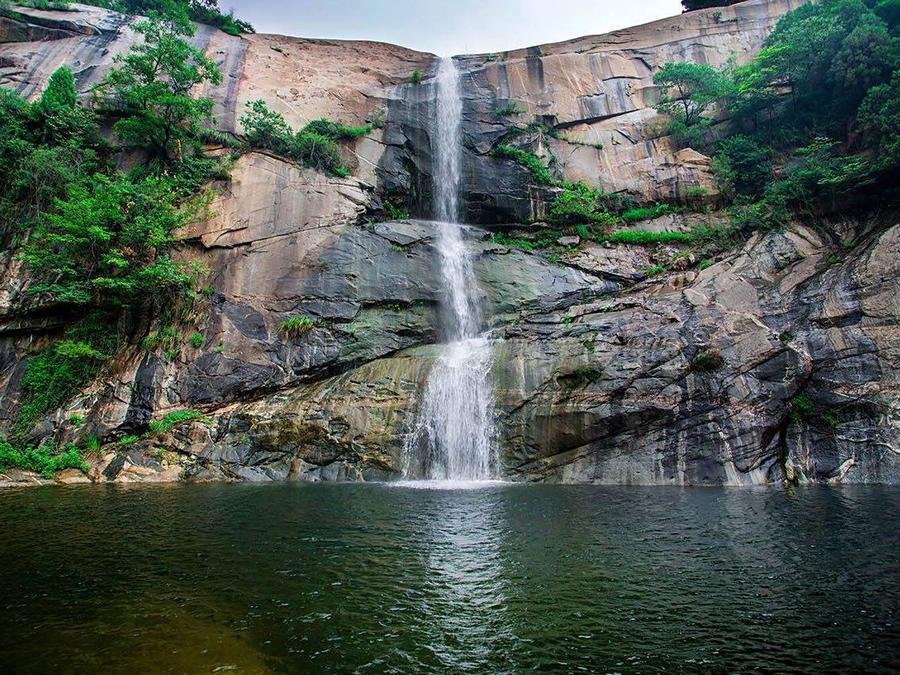
Heilongtan is located at the westernmost end of the scenic area, surrounded by mountains with clear, deep water fed by mountain springs. In the summer, while the outside temperatures are scorching, the pool remains cool and pleasant, making it an ideal summer retreat. A small temple dedicated to the Dragon King, where people pray for rain and favorable weather, is built on the northern hillside above Heilongtan. Qingling Valley is located around Heilongtan. Following the winding stone path through the secluded valley, visitors will encounter streams, waterfalls, springs, and pools, along with numerous peaks, cliffs, gorges, and unique rock formations. The opposing mountain peaks and rugged rocks create a variety of distinct and picturesque landscapes.
Map and Recommended Routes
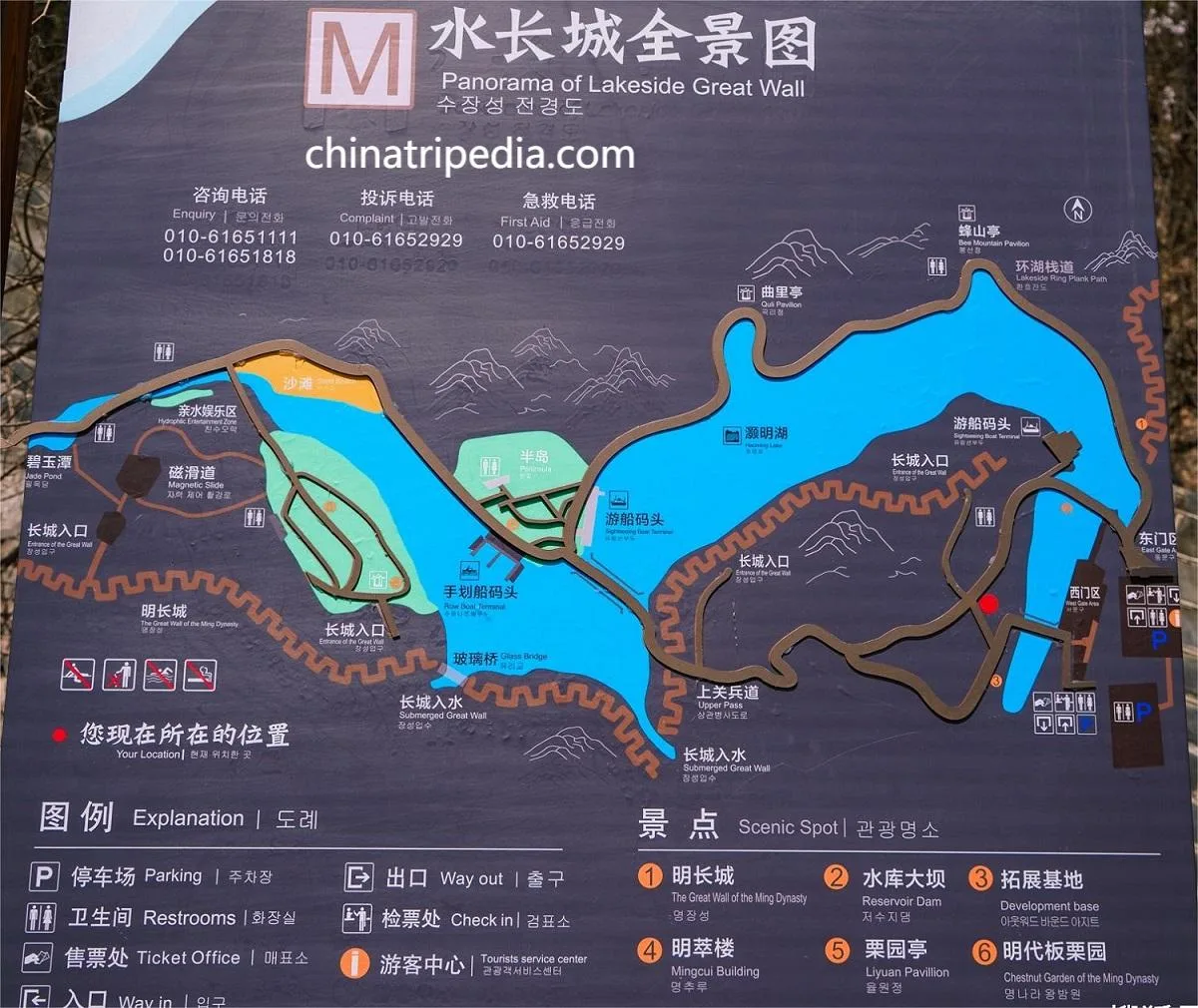
Route 1: Approximately 1.5 km of Great Wall Hiking (suitable for young children and the elderly)
East Gate → Reservoir Dam → Ming Great Wall Entrance beside the Boat Dock → Approximately 1.5 km of Great Wall Hiking → Great Wall into Water → Cross-Lake Bridge → Rowboat → Beach → Haoming Lake → Speedboat/Boat → Reservoir Dam → East Gate (route can be walked in reverse)
Notes: This section of the Great Wall is friendly, with gentle steps. Children can enjoy rowing boats and playing in the sand. The overall cost is low, offering good value for money.
Route 2: Approximately 2.5 km of Great Wall Hiking
East Gate → Reservoir Dam → Haoming Lake → Speedboat/Boat → Beach → Water Recreation Area → Magnetic Slide Round Trip (optional, offers scenic views from the top) → Ming Dynasty Chestnut Garden → Glass Bridge → Approximately 1 km of Great Wall Hiking → Great Wall into Water → Approximately 1.5 km of Great Wall Hiking → Reservoir Dam → East Gate
Notes: The steps near the Glass Bridge are quite high, not suitable for the elderly. This route passes through most children’s play areas, allowing kids to enjoy along the way. There are two Great Wall entry points for close-up views, and the magnetic slide is optional.
Route 3: Approximately 4 km of Great Wall Hiking
Entrance → Reservoir Dam → Haoming Lake → Speedboat/Boat → Beach → Magnetic Slide Up → Mountain Top Viewing Platform → Approximately 1.5 km of Great Wall Hiking → Glass Bridge → Approximately 1 km of Great Wall Hiking → Great Wall into Water → Approximately 1.5 km of Great Wall Hiking → Reservoir Dam → East Gate
Notes: This route covers the entire section of the Great Wall, taking more time. It is recommended to take the magnetic slide up, then hike along the Great Wall down to the Glass Bridge, avoiding retracing your steps.
Route 4: 2 km of Lakeside Plank Path + 1.5 km of Great Wall Hiking
Entrance → 2 km of Lakeside Plank Path → Cross-Lake Bridge → Great Wall into Water → Approximately 1.5 km of Great Wall Hiking → Reservoir Dam → East Gate
Notes: This route does not pass through the children’s area. The lakeside plank path follows the shape of the lake and the mountain, offering excellent scenery.
Vlog about Huanghuacheng Water Great Wall
Best Time to Visit
The ideal times to visit Huanghuacheng Water Great Wall are during the spring and autumn seasons. During Spring, especially around the Qingming Festival, the western mountainous area of Huairou comes alive with blooming crabapple, lilac, apricot, and pear blossoms, adding vibrancy and beauty to the landscape. The tourism area also hosts poetry gatherings and other cultural events, providing visitors with rich cultural experiences.
The autumn scenery is at its peak, making it the best time to enjoy the contrasting landscapes of northern and southern China. The vibrant autumn colors and pleasant weather enhance the beauty of the Great Wall and its surroundings.
Popular Restaurants near the Great Wall
| Restaurant | Highlights | Location |
|---|---|---|
| Xinli Restaurant 新利酒家 | Local favorite with good donkey meat and fish dishes. Reliable and reasonably priced. | Opposite Jiuduhe Gas Station, Jiuduhe Town, Huairou District |
| Hetang Weidao 荷塘味道 | Scenic lotus pond with white geese. Notable for its serene atmosphere and reliable dishes, especially Sister-in-law’s Tofu. | Near Huanghuacheng Reservoir, Ansi Road, Jiuduhe Town, Huairou District |
| The Verse | Trendy café and Western restaurant with freshly ground coffee and a variety of Western dishes. Prices similar to the city. | Near Huanghuacheng Reservoir, Ansi Road, Jiuduhe Town, Huairou District |
| Tianyuan Fish Port 天源鱼港 | Known for fresh fish, including unique large fish. Offers a variety of fish dishes, including homemade crispy fish. | Koulou Village, Jiuduhe Town, Huairou District |
Photography Spots and Tips
From the Beacon Tower: After climbing to the top, take photos from the beacon tower looking down. The view from here is stunning, offering a panoramic perspective of the wall snaking through the lush landscape.
Glass Bridge: Capture photos from the glass bridge or while standing on it. The transparent bridge provides unique angles and reflections, making for striking shots of the scenery below.
Magnetic Slide The small cars on the magnetic slide are also great for photos. You can have a friend take pictures of you as you ride, capturing the fun and dynamic aspect of your visit while they take a break.


